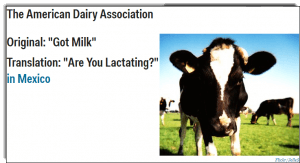“If you talk to a man in a language he understands, that goes to his head.
If you talk to him in his language, that goes to his heart.”
Nelson Mandela
The big multinationals have been doing it for decades. The Coca-Colas, Volkswagens and Unilevers of the world spend many millions every year to ensure that their corporate brand identity is properly conveyed in highly diverse markets around the globe. Brand plays a major role in creating that all-important emotional connection between consumers and a company and its products. Borrowing from Nelson Mandela’s philosophical insight (see sidebar), even in today’s global markets where, for example, English is often widely understood, a brand can only reach an audience’s heart if it talks the local language.
Lost in translation…
Languages are subtle and nuanced. Unless you’re talking about highly structured, functional text, it is not unusual that two translators would produce somewhat different finished texts, with both being equally accurate.

It is particularly important that copywriting texts be localized with great care. Translations that are too literal will lead to embarrassing bloopers such as the one shown on the right.[1] Above and beyond the semantic meaning, the translator also has to capture brand-building language qualities such as style and tone.
Going beyond translation – transcreation
The art of preserving brand equity during localization has spawned its own specialty: transcreation, i.e., translation + creation.
While translators seek to reproduce the wording and intent of a message, transcreators are copywriter linguists who seek to evoke the intended emotional response by re-creating the message in a way that resonates strongly with locals.[2] The aim of a transcreated message is to successfully capture the contextual relevance of the source message in the new language — words, graphics, video, audio, and cultural nuances.[3]
In order to achieve this goal, transcreators need to receive not only the source text, but the complete creative brief that underlies the campaign. The output of the transcreative copywriting effort will be brand new messaging that is carefully targeted to the local market.[4]
Here’s an example of transcreation from US to UK English[5]. Back in the days when fax machines were just becoming affordable, a US manufacturer of a super-fast fax machine ran a campaign using the strap line “Don’t go postal” over an image of a harried office worker holding a stack of urgent letters. The implication was clear: faxing the letters would be more reliable and less stressful than sending them by mail. It was a dark-humor play on the American slang expression “Go postal”, which means to lash out violently and at random and is taken from incidents in the 1990’s of workplace violence involving US postal system workers. The transcreators in the UK did not feel that the highly contextual strap line would go over well locally so they came up with a UK alternative: “Fax. Relax.” Totally different words, same message.
Transcreation is generally more expensive than straight translation. But in today’s highly competitive retail environment, can you afford to have your message and your brand equity undermined by ineffectively localized marketing and sales collateral?
Learn about Morningside’s transcreation services here.
References
[1] Laura Stampler, The 11 Worst Foreign Ad Translation Fails, Business Insider, May 17, 2012
[2] Transcreation FAQ: What you need to know about creative translation, Grainne Maycock, March 19, 2015
[3] What is Transcreation?, May 12, 2014
[4] Six Ways Transcreation Differs from Translation, Nataly Kelly, July 21, 2014


